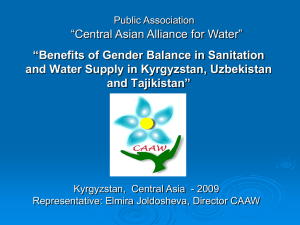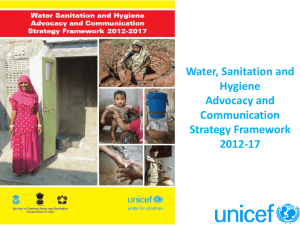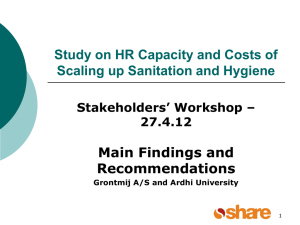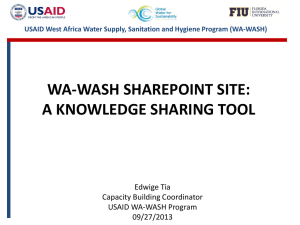PHAST - GreenNexxus
advertisement
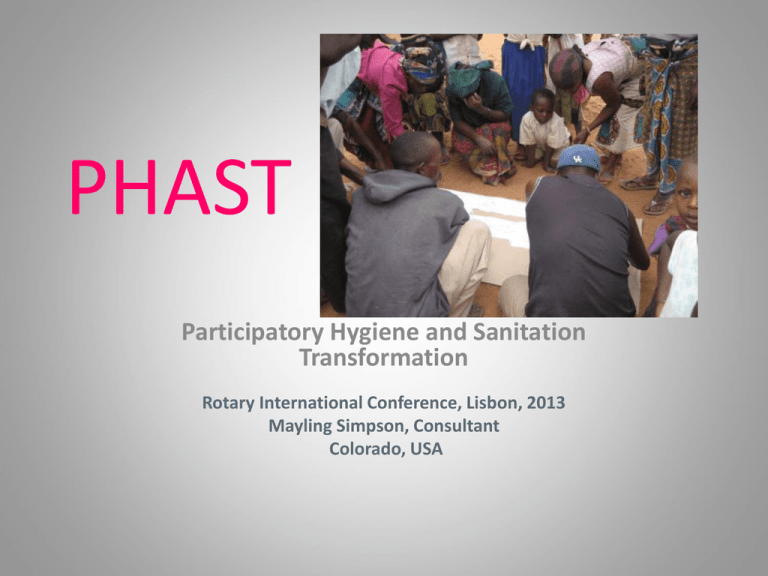
PHAST Participatory Hygiene and Sanitation Transformation Rotary International Conference, Lisbon, 2013 Mayling Simpson, Consultant Colorado, USA Community planning meetings often start out like this. With PHAST, they end up like this…….. And like this – led by the community What is PHAST? • A participatory approach to working with communities on sanitation, hygiene and water. • A methodology based on SARAR • Developed from field-testing 199496 Africa, Asia, Latin America, USA SARAR nurtures: • Self-esteem • Associative strengths • Resourcefulness • Action-planning • Responsibility Underlying principles of SARAR • People will solve their own problems best in a participatory group process. • A group collectively will have enough information and experience to begin to address its own problems. The aim of PHAST • To empower communities to manage their water and to control sanitation-related diseases. • By promoting health awareness and understanding which leads to environmental and behavioral improvements. How PHAST works • PHAST uses methods and materials that stimulate the participation of women, men and children in the development process. • It uses trained extension workers and graphic materials that reflect the culture and characteristics of communities. Underlying Principles of PHAST Lasting change in people’s behavior requires health awareness and understanding. To change their behaviors, people must believe that better hygiene and sanitation will lead to better health and better living. Concept-based learning • Concept-based learning is more effective in bringing about sustainable change than message-based teaching. • PHAST is based upon concept-based learning. Bringing people together to plan changes • Assessing their own knowledge base. • Investigating their own environmental situation. • Visualizing a future scenario. • Analyzing constraints to change • Planning for change • Implementing change. Community Development Principles of PHAST • Communities should determine their own priorities for disease prevention. • People collectively possess an enormous depth of experience and knowledge. • Communities are capable of arriving at a consensus on hygiene behaviors and sanitation systems. Community Development Principles of PHAST (continued) • When people understand why improved sanitation and hygiene is to their advantage, they will act. • All people are capable of understanding that faeces carry disease and can learn to trace and describe the faecal-oral route. • Communities can identify appropriate barriers to block this transmission. PHAST- 7 steps • • • • • • • 1. Problem identification 2. Problem analysis 3. Planning for solutions 4. Selecting the options 5. Planning for new facilities and behavior change 6. Planning for monitoring and evaluation 7. Participatory evaluation Tools and Techniques • Role plays of behaviors, illnesses • Community walks and maps • Making the feces transmission routes using drawings • Sorting drawings of good and bad hygiene behaviors • Sorting drawings of sanitation options • Selecting what the community wants fingers Hand washing flies Cooking faeces Pit toilet VIP, flush or ecological toilet food Washing fields fluids mouth Boiling or disinfection Pictures instead of words • PHAST uses drawings to illustrate ideas so that illiterate people can participate. Making a Community Map - Eritrea Principles on decision-making • The people closest to the problem are those best able to find the solution. • The community understands its own situation best. • Those who create decisions will be committed to following them through. Principles on decision-making (continued) • The more of their own material and financial resources people invest in change, the greater will be their commitment to following it through and sustaining it. • Self-esteem is a prerequisite to decisionmaking and follow-through. Key factors needed for effective participation • Respect for people’s knowledge and ideas • Faith in the creative potential of people • Minimum of structure; maximum of participation • Loyalty to the group • Commitment to helping people express themselves. Is PHAST successful? YES PHAST has been applied in over 20 countries: Latin America, East Africa, West Africa, Former Soviet Republics, and USA. Getting Ready to do PHAST • Facilitator training – 2 weeks • Artist to make drawings of local environments and cultures Requirements for Success • • • • Training of facilitators Plenty of time with the community Willingness to budget the software sufficiently Allowing the community to own the process and project • Do this at the beginning, not at the end! CHAST Children’s Hygiene And Sanitation Training Primary School children ages 5 to 12 History Grew out of PHAST Created in 2004 for Somalia. (Caritas Swiss & Luxembourg) Adopted by Gov. of Kenya in 2007 CHAST Tools 3 story characters 1 or more puppets (with names) Colored posters Role plays Puppet shows Card games Songs Art 5 Steps for Children’s Hygiene Behaviors Introduction Problem Identification Problem Analysis Practicing Good Behavior Monitoring Further reading (see handout) • PHAST Theory: Participatory Hygiene and Sanitation Transformation: A new approach to working with communities, 1996, WHO. • PHAST Practice: PHAST Step-by-step Guide: A participatory approach for the control of diarrhoeal disease, 1998, WHO • CHAST – A Practical Guide, 2004, Caritas Switzerland
